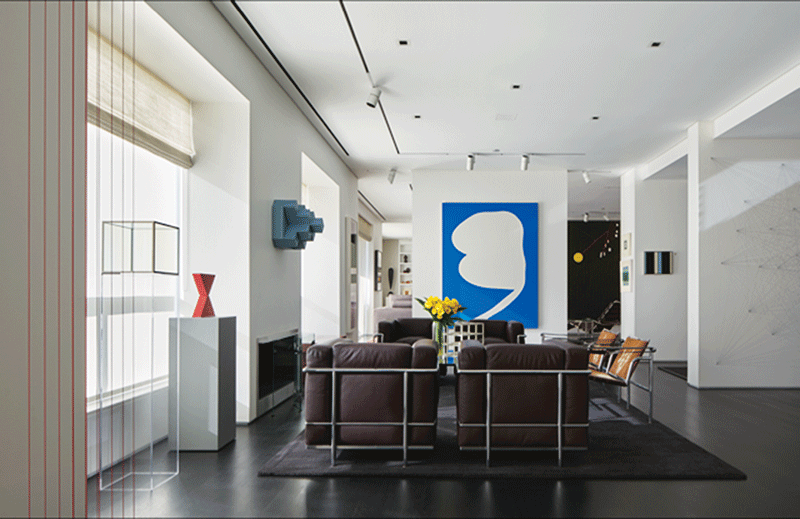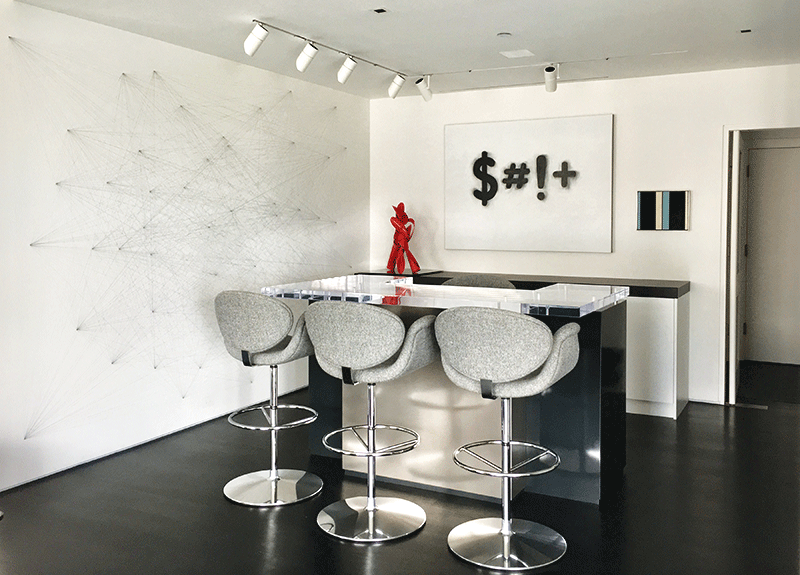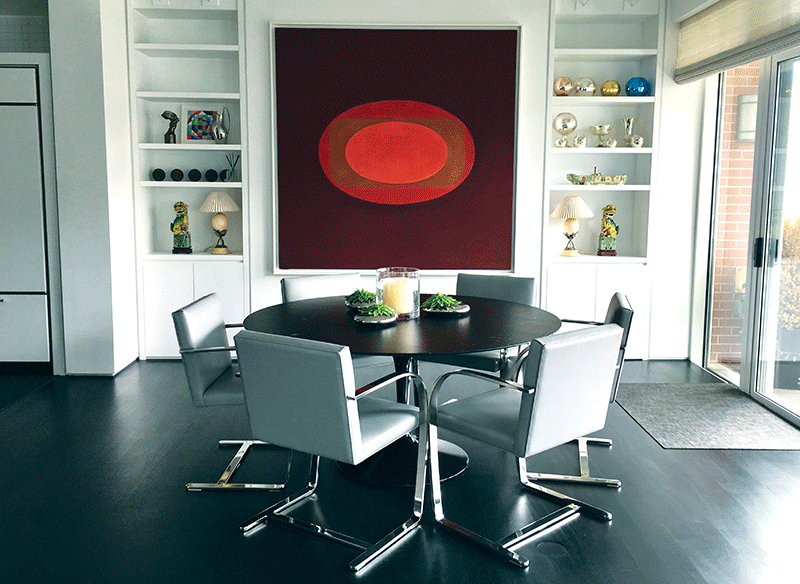Collector Irving Stenn Jr.: A Lifetime of Relationships Through Art


By GINNY VAN ALYEA
Three years ago Irving Stenn Jr. significantly changed the Art Institute of Chicago’s collection of Minimalist art and works on paper by gifting 105 drawings to the museum. Growing up, Stenn would have never imagined that he would come to love art and pursue and acquire such a significant collection in his lifetime. Born and raised on the South Side of Chicago, with parents who were products of the Depression, he says he didn’t visit many museums as a child, outside of a few school trips. Today, at age 86, he is a Trustee Emeritus of the Art Institute.
Stenn lives in a recently renovated, 13th floor Streeterville condo with his wife Judi. Seated in a brown leather Le Corbusier chair, with a view of the park that is just east of the Museum of Contemporary Art, Stenn reflects, “I was so fortunate to have attended the University of Michigan and live with a group of young men who were very interested in the arts.” It was because of these friends that he was inspired to take art survey courses while he was a student, and when he returned to Chicago as a young lawyer, he made time to attend the symphony, art exhibitions and to visit museums.
Soon he married Marcia Sachs, with whom he had three children. Together they bought a Victorian rooming house in Lincoln Park that the city claimed was uninhabitable, due to prior flood damage. Referencing old photographs of what the building looked like originally, the couple undertook an extensive renovation with their friend, architect, Harry Weese.
Stenn describes the process, “It was a crazy thing to do with three little kids running around at the time, but it was also really an exciting thing to see the house come together.”

When everything was complete, the couple was living in a home filled with white walls. The architect suggested to them that the house was a perfect place to display art.
On a trip to San Francisco, they visited Gumps Department Store, a well-known store in the city, which had an art department. One vivid, geometric print caught the couples’ eye. Stenn recalls, “The artist’s name was not familiar to us at the time. My wife liked the color and design, so we sent it home.” The piece was titled River of Ponds and the artist was Frank Stella. It was the first work of art they purchased together, and it is still in Stenn’s collection. Over time that Stella print has proven to be seminal in the focus of his collection.
Back in Chicago, the couple continued collecting prints by artists of the 50’s, 60’s and 70’s with the help of dealer William van Straaten. They continued their quest by beginning relationships with Donald Young, Rhona Hoffman, Richard Gray and many other gallerists, relying on them for guidance.
Stenn says, “Under the thoughtful tutelage of Donald and Rhona – and as our confidence, eye and pocketbook grew – we began to acquire paintings, and sculpture as well.” They sought out artists such as Jasper Johns, Roy Lichtenstein, Josef Albers and Sol Lewitt.

Over time Stenn says that through their collecting they met many interesting people, gaining insight into what contemporary art was about. They became an active part of the art community, and eventually Stenn was asked to be a Trustee of the Museum of Contemporary Art. He spent time studying exhibitions and engaging with other supporters of the museum. He explains, “In my law practice I was introduced to Gerry Elliott, a premier Chicago collector who put together collections of several periods of art during his lifetime, a number of which were gifted to the Museum of Contemporary Art and to the Art Institute in Chicago. The three of us would often meet at our house, where we discussed art and artists, and it was through Gerry that we gained in-depth familiarity with the artists whom we began to collect, such as Donald Judd, Barnett Newman, Brice Marden and Robert Ryman.”
While Stenn’s engagement with art increased, he still viewed himself as just an art enthusiast. He and Marcia were occupied raising their children, and he was busier than ever working as a lawyer. He remembers clearly, “One day, I don’t know how many years went by, someone called and asked to visit to see our collection of contemporary art That was the first time I’d ever heard anyone say, ‘You have a collection’. I’d never thought of it that way.”
Marcia passed away in 1999. About a year later, in early in 2000, Mark Pascale, The Janet and Craig Duchossois Curator of Prints & Drawings at the Art Institute, called and introduced himself. He proposed a visit to an exhibit of contemporary drawings from the Collection of Werner Kramarsky, an internationally respected contemporary drawings collector, that was to be shown at the Mary and Leigh Block Museum of Art on the Northwestern Campus.
“I was fascinated with the material," Stenn says, "because the intimate nature of the drawings and works on paper gave me insight into the process of this art. I was hooked!”

Stenn and Pascale continued to talk regularly, and Stenn found himself with a new mentor in a new genre in the period he so loved. They traveled together in search of drawings by Ellsworth Kelly, Mel Bochner, Josef Albers, Agnes Martin, Fred Sandback, Jasper Johns, James Turrell, and so on. The collection that resulted was exhibited at the Art Institute in 2014, and the museum acknowledges that the bequest was one of the most significant bodies of works on paper given to the museum. It has meaningfully enlarged the Department of Prints and Drawings’ collection.
During these years of collecting, Stenn became a Trustee of the Art Institute. In addition he stepped up his commitment to the University of Michigan Museum of Art by naming a gallery in the contemporary wing in 2007. He is also a member of the school’s National Leadership Council.
Five years ago, Stenn’s wife Judi came into his life. As a designer, she worked with the architects to accommodate as much of the art as possible, placing works that once filled his large Lincoln Park home in a fresh new space in their downtown apartment. Here, art is everywhere, behind the bar, as well as on the sitting room floor. The installations show each piece’s individual attributes as well as the interesting ways they speak to one another.
A small-scale, cubed Sol LeWitt sculpture has been placed atop a glass coffee near a vibrant Ellsworth Kelly painting, not far from a small bar, where a large LeWitt wall drawing has been installed for the second time, since it was formerly in his Lincoln Park home.
A narrow hallway –– lined with dozens of framed drawings by artists such as Fred Sandback, Martin Puryear, Kazimir Malevich, and Yves Klein –– leads to a floor-to-ceiling, dark blue Roy Lichtenstein felt banner entitled Lightning Bolt.
An Alexander Calder mobile floats near a steel-tiled Carl Andre floor installation. Says Stenn, “We love living with as much of the collection as possible.”
For Stenn, “The collecting of art has not only been an education, it has broadened my life in so many ways. I’ve met and become friends with wonderful people in Chicago and around the globe. There have been many gallerists and curators who have been instrumental in building the collection over the years –– too many to mention –– and I am eternally grateful. Art has expanded my world. While there have been some bumps along the way, it’s been a good life. I’m a lucky guy!”







